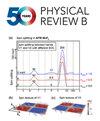Operator spreading in random unitary circuits with unitary-invariant gate distributions
IF 3.7
2区 物理与天体物理
Q1 Physics and Astronomy
引用次数: 0
Abstract
Random unitary circuits have become a model system to investigate information scrambling in quantum systems. In the literature, mostly random circuits with Haar-distributed gate operations have been considered. In this work, we investigate operator spreading in random unitary circuits in which the elementary gate operations are drawn from general unitary-invariant ensembles, which include the well-studied Haar-distributed random unitary circuits as a special case. Similar to the Haar-distributed case, the long-time behavior of operator spreading with the more general unitary-invariant gate distribution is governed by drift-diffusion equations characterized by the butterfly velocity vB and a diffusion constant具有酉不变门分布的随机酉电路中的算子扩展
随机酉电路已成为研究量子系统中信息置乱的一种模型系统。在文献中,大多考虑了具有haar分布门运算的随机电路。在这项工作中,我们研究了算子在随机酉电路中的传播,其中初等门运算是从一般酉不变系综中得出的,其中包括作为特殊情况的haar分布随机酉电路。与haar分布情况类似,更一般的酉不变门分布的算子扩展的长期行为由由蝴蝶速度vB和扩散常数d表征的漂移扩散方程控制,与haar随机情况的不同之处是:(i)它需要有限的时间τb,直到集合平均Pauli-string权值为“二进制”形式;其中,它们仅依赖于泡利强支持下的泡利算子是否等于单位矩阵,以及(ii)算子的扩展以有限的“域壁宽度”nDW为特征,该nDW分隔具有随机矩阵样泡利串分布的区域。为了说明这些发现,我们对根据泊松核分布的随机酉电路进行显式计算,泊松核在平凡和哈尔分布电路之间进行插值。2025年由美国物理学会出版
本文章由计算机程序翻译,如有差异,请以英文原文为准。
求助全文
约1分钟内获得全文
求助全文
来源期刊

Physical Review B
物理-物理:凝聚态物理
CiteScore
6.70
自引率
32.40%
发文量
0
审稿时长
3.0 months
期刊介绍:
Physical Review B (PRB) is the world’s largest dedicated physics journal, publishing approximately 100 new, high-quality papers each week. The most highly cited journal in condensed matter physics, PRB provides outstanding depth and breadth of coverage, combined with unrivaled context and background for ongoing research by scientists worldwide.
PRB covers the full range of condensed matter, materials physics, and related subfields, including:
-Structure and phase transitions
-Ferroelectrics and multiferroics
-Disordered systems and alloys
-Magnetism
-Superconductivity
-Electronic structure, photonics, and metamaterials
-Semiconductors and mesoscopic systems
-Surfaces, nanoscience, and two-dimensional materials
-Topological states of matter
 求助内容:
求助内容: 应助结果提醒方式:
应助结果提醒方式:


